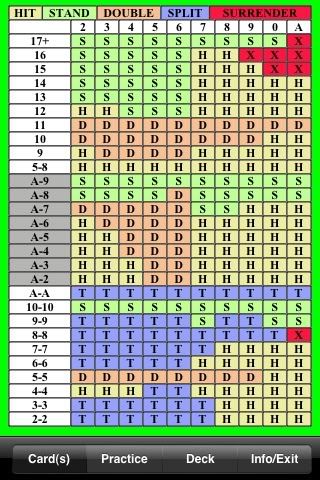Deathclutch
Well-Known Member
First of all I'd like to thank everyone for your their help because your advice has me winning so far, but I've run across this situation here.
Now I know that my casino will have a slightly different basic strategy due to surrender being allowed and also the H17, so my basic strategy looks like this.

Now my assumption is that basic strategy is the best way to play certain rules at a count of 0.
Now this is where my problem comes in. I'm playing using the KISS III count and am starting to use the different indices as are explained in Fred's book. Some of his indices go against basic strategy even at my beginning count, which is making me wonder if the indices were made to play against a game with a S17 rule set. Let me provide a couple examples.
As you can see on the chart BS says I should surrender a 15 vs. a 10. Well in the book it says I surrender a 15 vs. a 10 at 12+ for a shoe game. (For those that don't know the count starts at 9). So if I'm playing heads up and this is my first hand would I go ahead and hit against it as if surrender wasn't an option, or would I follow BS?
Another example would be the book states I should Double a 11 vs. an Ace at 20+. According to BS I always should. Which one do I follow?
Last example. The book says I should Double down on A/7 vs. a 2 at 19+. BS says I always should. Thank you guys again for all the help, you've all already helped me win more than I thought I would be so soon.
Now I know that my casino will have a slightly different basic strategy due to surrender being allowed and also the H17, so my basic strategy looks like this.

Now my assumption is that basic strategy is the best way to play certain rules at a count of 0.
Now this is where my problem comes in. I'm playing using the KISS III count and am starting to use the different indices as are explained in Fred's book. Some of his indices go against basic strategy even at my beginning count, which is making me wonder if the indices were made to play against a game with a S17 rule set. Let me provide a couple examples.
As you can see on the chart BS says I should surrender a 15 vs. a 10. Well in the book it says I surrender a 15 vs. a 10 at 12+ for a shoe game. (For those that don't know the count starts at 9). So if I'm playing heads up and this is my first hand would I go ahead and hit against it as if surrender wasn't an option, or would I follow BS?
Another example would be the book states I should Double a 11 vs. an Ace at 20+. According to BS I always should. Which one do I follow?
Last example. The book says I should Double down on A/7 vs. a 2 at 19+. BS says I always should. Thank you guys again for all the help, you've all already helped me win more than I thought I would be so soon.
